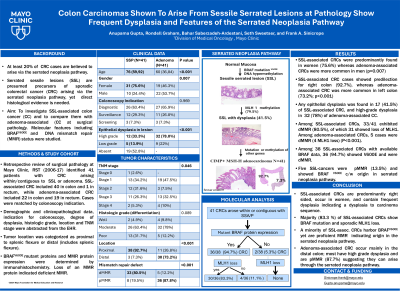Tuesday Poster Session
Category: Colon
P3632 - Colon Carcinomas Shown to Arise From Sessile Serrated Lesions (SSLs) at Pathology Show Frequent Dysplasia and Features of the Serrated Neoplasia Pathway
Tuesday, October 29, 2024
10:30 AM - 4:00 PM ET
Location: Exhibit Hall E

Has Audio
- AG
Anupama Gupta, MBBS
Mayo Clinic
Rochester, MN
Presenting Author(s)
Anupama Gupta, MBBS1, Rondell Graham, MBBS, MD1, Bahar Saberzadeh-Ardestani, MBBS2, Seth Sweetser, MD1, Frank A. Sinicrope, MD1
1Mayo Clinic, Rochester, MN; 2Yale school of Medicine, New Haven, CT
Introduction: Serrated sessile lesions (SSLs) are presumed precursors of colorectal cancer (CRC) yet are rarely identified in direct association with the cancer histopathologically, in contrast to adenomas. SSLs are believed to arise from the serrated neoplasia pathway that is characterized by BRAF mutation, a methylator phenotype, and frequent deficient mismatch repair (d-MMR). To provide further evidence of the role of SSLs as precursor lesions of CRC, we sought to identify SSLs in direct association with CRCs at surgical pathology and examined their BRAF and MMR status. Whereas BRAFV600E has not been shown to be prognostic in d-MMR tumors, BRAFV600E is adversely prognostic in pMMR CRCs.
Methods: We retrospectively reviewed a surgical pathology database at Mayo Clinic (2006 -2017) to identify colon carcinomas (CCs) arising within or contiguous to an SSL. From the electronic health record, we reviewed surgical pathology and colonoscopy reports and abstracted demographic and tumor clinicopathological data. Immunohistochemical status of mismatch repair (MMR) proteins and BRAF (V600E) status, where available, were determined and recorded.
Results: Colon adenocarcinomas (N=42) arising within or contiguous to an SSL were identified. Median patient age was 75 years, 32 (76.2%) were female and 39 (92.8%) were located in the proximal colon. Epithelial dysplasia was identified in 18 (43%) CC-associated SSLs. TNM stage of SSL-associated CC included one stage 0 (2.5%), 14 stage I (35%), 12 stage II (30%), 11 stage III (27.5%), and 2 stage IV (5%) tumors. Of the 42 cancers, 33 (78.6%) had dMMR and 9 (21.4%) showed proficient MMR (pMMR). Of 37 cancers with available BRAF data, 32 (86.5%) tumors with dMMR harbored BRAFV600E and 5 ( 13.5%) pMMR tumors had the V600E mutation. Among the 33 dMMR cases, 30 (85.7%) show loss of MLH1; 3 were not tested.
Discussion: We observed SSLs with frequent dysplasia in direct association with CCs. A majority of SSL-associated cancers were proximal, harbored BRAFV600E and showed sporadic dMMR due to loss of MLH1. SSL-associated cancers also include pMMR tumors with BRAFV600E indicating that both can develop through the serrated neoplasia pathway with reported distinct differences in treatment response and prognosis.
Disclosures:
Anupama Gupta, MBBS1, Rondell Graham, MBBS, MD1, Bahar Saberzadeh-Ardestani, MBBS2, Seth Sweetser, MD1, Frank A. Sinicrope, MD1. P3632 - Colon Carcinomas Shown to Arise From Sessile Serrated Lesions (SSLs) at Pathology Show Frequent Dysplasia and Features of the Serrated Neoplasia Pathway, ACG 2024 Annual Scientific Meeting Abstracts. Philadelphia, PA: American College of Gastroenterology.
1Mayo Clinic, Rochester, MN; 2Yale school of Medicine, New Haven, CT
Introduction: Serrated sessile lesions (SSLs) are presumed precursors of colorectal cancer (CRC) yet are rarely identified in direct association with the cancer histopathologically, in contrast to adenomas. SSLs are believed to arise from the serrated neoplasia pathway that is characterized by BRAF mutation, a methylator phenotype, and frequent deficient mismatch repair (d-MMR). To provide further evidence of the role of SSLs as precursor lesions of CRC, we sought to identify SSLs in direct association with CRCs at surgical pathology and examined their BRAF and MMR status. Whereas BRAFV600E has not been shown to be prognostic in d-MMR tumors, BRAFV600E is adversely prognostic in pMMR CRCs.
Methods: We retrospectively reviewed a surgical pathology database at Mayo Clinic (2006 -2017) to identify colon carcinomas (CCs) arising within or contiguous to an SSL. From the electronic health record, we reviewed surgical pathology and colonoscopy reports and abstracted demographic and tumor clinicopathological data. Immunohistochemical status of mismatch repair (MMR) proteins and BRAF (V600E) status, where available, were determined and recorded.
Results: Colon adenocarcinomas (N=42) arising within or contiguous to an SSL were identified. Median patient age was 75 years, 32 (76.2%) were female and 39 (92.8%) were located in the proximal colon. Epithelial dysplasia was identified in 18 (43%) CC-associated SSLs. TNM stage of SSL-associated CC included one stage 0 (2.5%), 14 stage I (35%), 12 stage II (30%), 11 stage III (27.5%), and 2 stage IV (5%) tumors. Of the 42 cancers, 33 (78.6%) had dMMR and 9 (21.4%) showed proficient MMR (pMMR). Of 37 cancers with available BRAF data, 32 (86.5%) tumors with dMMR harbored BRAFV600E and 5 ( 13.5%) pMMR tumors had the V600E mutation. Among the 33 dMMR cases, 30 (85.7%) show loss of MLH1; 3 were not tested.
Discussion: We observed SSLs with frequent dysplasia in direct association with CCs. A majority of SSL-associated cancers were proximal, harbored BRAFV600E and showed sporadic dMMR due to loss of MLH1. SSL-associated cancers also include pMMR tumors with BRAFV600E indicating that both can develop through the serrated neoplasia pathway with reported distinct differences in treatment response and prognosis.
Disclosures:
Anupama Gupta indicated no relevant financial relationships.
Rondell Graham indicated no relevant financial relationships.
Bahar Saberzadeh-Ardestani indicated no relevant financial relationships.
Seth Sweetser indicated no relevant financial relationships.
Frank Sinicrope: Guardant Health – Advisory Committee/Board Member. Hoffman La Roche – Advisor or Review Panel Member.
Anupama Gupta, MBBS1, Rondell Graham, MBBS, MD1, Bahar Saberzadeh-Ardestani, MBBS2, Seth Sweetser, MD1, Frank A. Sinicrope, MD1. P3632 - Colon Carcinomas Shown to Arise From Sessile Serrated Lesions (SSLs) at Pathology Show Frequent Dysplasia and Features of the Serrated Neoplasia Pathway, ACG 2024 Annual Scientific Meeting Abstracts. Philadelphia, PA: American College of Gastroenterology.
